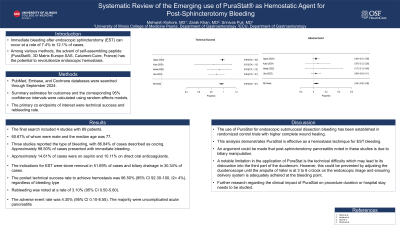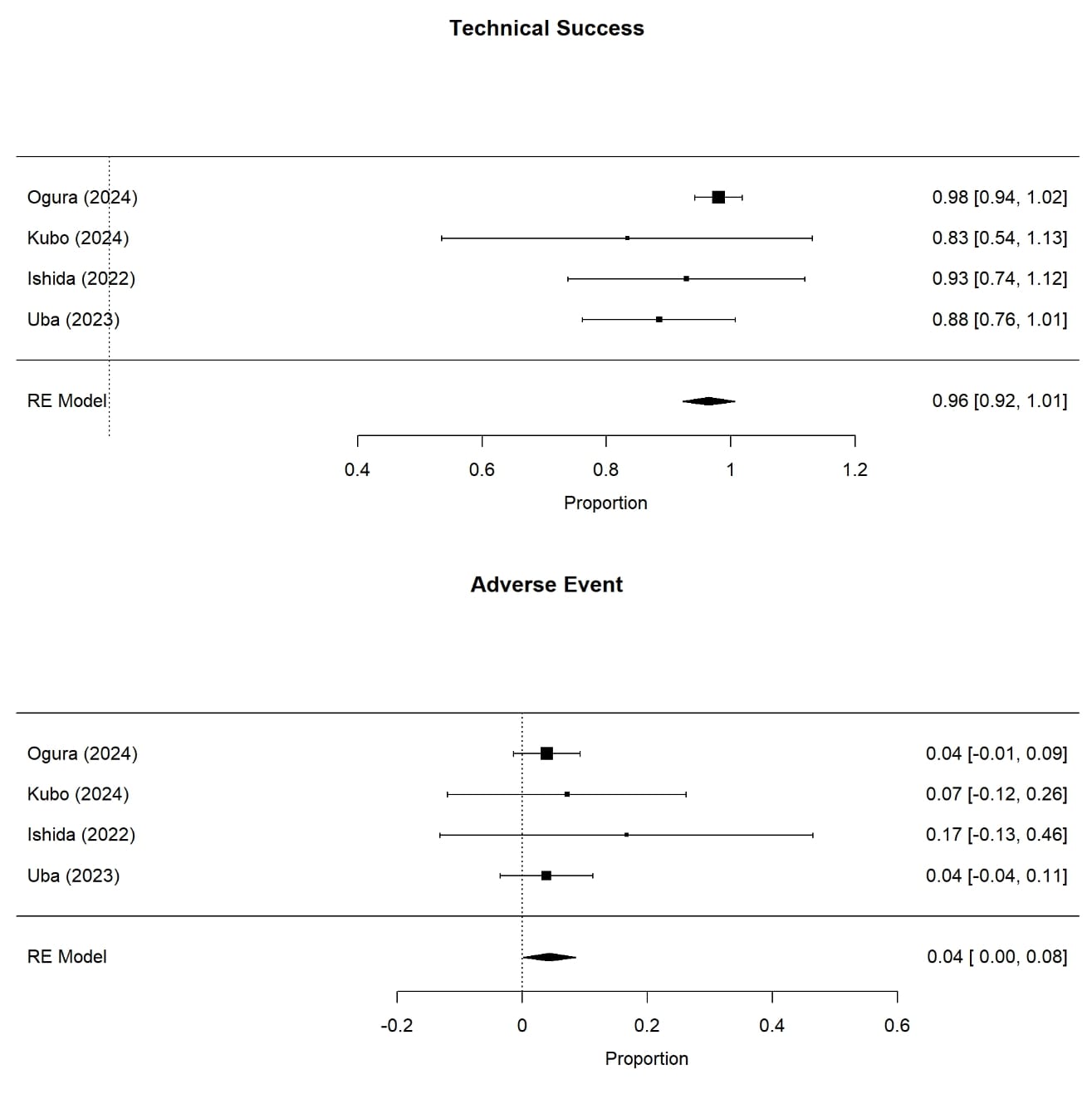Monday Poster Session
Category: Biliary/Pancreas
P1763 - Meta-Analysis and Systematic Review of the Emerging use of PuraStat® as Hemostatic Agent for Post-Sphincterotomy Bleeding
Monday, October 28, 2024
10:30 AM - 4:00 PM ET
Location: Exhibit Hall E

Has Audio
- MK
Mehwish Kishore, MD
University of Illinois College of Medicine
Peoria, IL
Presenting Author(s)
Mehwish Kishore, MD1, Zarak H. Khan, MD2, Srinivas Puli, MD1
1University of Illinois College of Medicine, Peoria, IL; 2East Carolina University, Greenville, NC
Introduction: Immediate bleeding after endoscopic sphincterotomy (EST) can occur at a rate of 7.4% to 12.1% of cases. Among various methods, the advent of self-assembling peptide (PuraStat®, 3D Matrix Europe SAS, Caluireet-Cuire, France) has the potential to revolutionize endoscopic hemostasis. This systematic analysis aims to study technical success and rebleeding rate.
Methods: A systemic search was performed from 2020-2024. Summary estimates for outcomes and the corresponding 95% confidence intervals (CI) were calculated using random-effects models. Meta-analysis was performed using the “metafor” package version 3.4-0 in R version 4.1.2.
Results: Initial search gave 77 number of papers. Of these, the final analysis included 4 studies with 89 patients, 60.67% of whom were male. The median age was 77 years. Three studies reported the type of bleeding, with 86.84% of cases described as oozing. Approximately 14.61% of cases were on aspirin and 10.11% on direct oral anticoagulants. The major indications for EST were stone removal in 51.69% of cases and biliary drainage in 30.34% of cases. Approximately 98.50% of cases presented with immediate bleeding. The pooled technical success rate to achieve hemostasis was 96.50% (95% CI 92.30-100, I2= 4%), regardless of bleeding type. Rebleeding was noted at a rate of 3.10% (95% CI 0.50-5.60). The adverse event rate was 4.30% (95% CI 0.10-8.50). The majority were uncomplicated acute pancreatitis.
Discussion: The use of PuraStat for endoscopic submucosal dissection bleeding has been established in randomized control trials with higher complete wound healing. This analysis demonstrates PuraStat is effective as a hemostasis technique for EST bleeding. An argument could be made that post-sphincterotomy pancreatitis noted in these studies is due to biliary manipulation. A notable limitation in the application of PuraStat is the technical difficulty which may lead to dislocation into the third part of the duodenum. However, this could be prevented by adjusting the duodenoscope until the ampulla of Vater is at 3 to 6 o’clock on the endoscopic image and ensuring delivery system is
adequately adhered at the bleeding point. Further research regarding the clinical impact of PuraStat on procedure duration or hospital stay needs to be studied.

Disclosures:
Mehwish Kishore, MD1, Zarak H. Khan, MD2, Srinivas Puli, MD1. P1763 - Meta-Analysis and Systematic Review of the Emerging use of PuraStat® as Hemostatic Agent for Post-Sphincterotomy Bleeding, ACG 2024 Annual Scientific Meeting Abstracts. Philadelphia, PA: American College of Gastroenterology.
1University of Illinois College of Medicine, Peoria, IL; 2East Carolina University, Greenville, NC
Introduction: Immediate bleeding after endoscopic sphincterotomy (EST) can occur at a rate of 7.4% to 12.1% of cases. Among various methods, the advent of self-assembling peptide (PuraStat®, 3D Matrix Europe SAS, Caluireet-Cuire, France) has the potential to revolutionize endoscopic hemostasis. This systematic analysis aims to study technical success and rebleeding rate.
Methods: A systemic search was performed from 2020-2024. Summary estimates for outcomes and the corresponding 95% confidence intervals (CI) were calculated using random-effects models. Meta-analysis was performed using the “metafor” package version 3.4-0 in R version 4.1.2.
Results: Initial search gave 77 number of papers. Of these, the final analysis included 4 studies with 89 patients, 60.67% of whom were male. The median age was 77 years. Three studies reported the type of bleeding, with 86.84% of cases described as oozing. Approximately 14.61% of cases were on aspirin and 10.11% on direct oral anticoagulants. The major indications for EST were stone removal in 51.69% of cases and biliary drainage in 30.34% of cases. Approximately 98.50% of cases presented with immediate bleeding. The pooled technical success rate to achieve hemostasis was 96.50% (95% CI 92.30-100, I2= 4%), regardless of bleeding type. Rebleeding was noted at a rate of 3.10% (95% CI 0.50-5.60). The adverse event rate was 4.30% (95% CI 0.10-8.50). The majority were uncomplicated acute pancreatitis.
Discussion: The use of PuraStat for endoscopic submucosal dissection bleeding has been established in randomized control trials with higher complete wound healing. This analysis demonstrates PuraStat is effective as a hemostasis technique for EST bleeding. An argument could be made that post-sphincterotomy pancreatitis noted in these studies is due to biliary manipulation. A notable limitation in the application of PuraStat is the technical difficulty which may lead to dislocation into the third part of the duodenum. However, this could be prevented by adjusting the duodenoscope until the ampulla of Vater is at 3 to 6 o’clock on the endoscopic image and ensuring delivery system is
adequately adhered at the bleeding point. Further research regarding the clinical impact of PuraStat on procedure duration or hospital stay needs to be studied.

Figure: Forest plot reporting pooled result of technical success of hemostasis and adverse event rate
Disclosures:
Mehwish Kishore indicated no relevant financial relationships.
Zarak Khan indicated no relevant financial relationships.
Srinivas Puli indicated no relevant financial relationships.
Mehwish Kishore, MD1, Zarak H. Khan, MD2, Srinivas Puli, MD1. P1763 - Meta-Analysis and Systematic Review of the Emerging use of PuraStat® as Hemostatic Agent for Post-Sphincterotomy Bleeding, ACG 2024 Annual Scientific Meeting Abstracts. Philadelphia, PA: American College of Gastroenterology.
